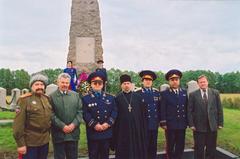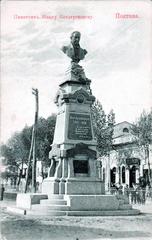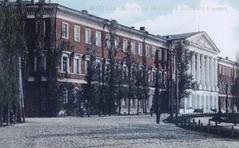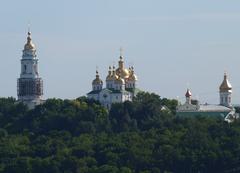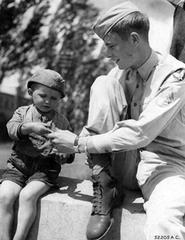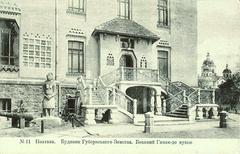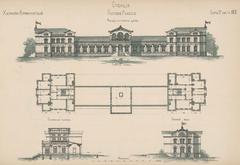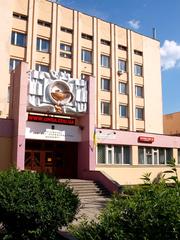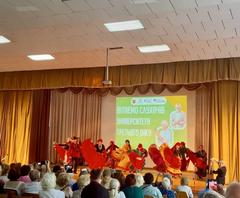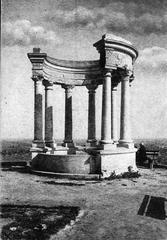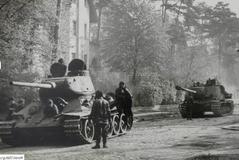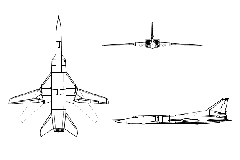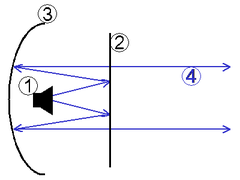
328 Km Poltava, Ukraine: Visiting Hours, Tickets, and Historical Sites Guide
Date: 04/07/2025
Introduction to 328 Km in Poltava, Ukraine
Poltava, nestled in the heart of Ukraine, stands as a beacon of history, culture, and resilience. Renowned for the pivotal Battle of Poltava in 1709, which dramatically altered the European balance of power and marked Russia’s emergence as a dominant empire, the city weaves together centuries-old traditions, striking architecture, and vibrant contemporary life. Its roots stretch back to ancient Paleolithic and Scythian cultures, and its historical layers are visible in monuments, museums, and living folk traditions (Wikipedia; Earth-Site; Encyclopedia of Ukraine).
From the iconic Poltava Battle Museum to ornate cathedrals and the bustling Sorochynsky Fair, the city invites travelers to explore its historical and cultural treasures. Convenient rail and road connections, accessible infrastructure, and a welcoming atmosphere ensure a rewarding visit for history buffs, architecture enthusiasts, and cultural explorers alike (WildTrips; Ukrainer). This guide offers a comprehensive overview of Poltava’s must-see sites, practical visitor information, and insider tips to help you plan a meaningful journey (explorecity.life; Rome2Rio; U.S. State Department Travel Advisory).
Table of Contents
- Discover Poltava: A Must-Visit Historical Destination
- Early Settlement and Medieval Development
- The Cossack Era and the Hetmanate
- The Battle of Poltava (1709): A Turning Point
- Architectural and Spiritual Heritage
- 19th Century: Cultural and Economic Flourishing
- Cultural Significance and Modern Identity
- Practical Visitor Information
- Top Attractions and Visiting Information for Poltava Historical Sites
- Local Traditions and Cultural Insights
- Visiting the Poltava Battle Monument: Travel, Tickets, and Accommodation Guide
- Visiting Poltava’s Assumption Cathedral: Safety, Language, and Visitor Etiquette Guide
- Summary and Visitor Recommendations for 328 Km Poltava
- References and Further Reading
Discover Poltava: A Must-Visit Historical Destination
Poltava is a city where Ukrainian identity and European history converge. Famed for its significant role in the Battle of Poltava, the city enchants visitors with a blend of historical sites, cultural festivals, and tranquil green spaces. Its welcoming community and rich traditions ensure every traveler leaves with lasting memories.
Early Settlement and Medieval Development
Poltava’s territory has been settled since ancient times, as evidenced by Paleolithic and Scythian artifacts (Wikipedia). The city is first mentioned in 1174, but local tradition marks its origins to the 9th century (Earth-Site). Its name comes from “Ltava,” the source of the Vorskla River (Discover Ukraine).
Strategically located, Poltava transitioned through the hands of the Siverianians, the Pereiaslav principality, the Golden Horde, Lithuania, and Poland. Despite devastation from invasions, Poltava was resettled in the 15th and 16th centuries, setting the stage for its Cossack era (Encyclopedia of Ukraine).
The Cossack Era and the Hetmanate
The Cossack period was formative for Poltava, as it became part of the Hetmanate and a hub for Ukrainian self-governance. The city’s starshyna (Cossack leadership) preserved local traditions and autonomy, and noble families fostered a strong sense of Ukrainian national identity (Encyclopedia of Ukraine).
The Battle of Poltava (1709): A Turning Point
The 1709 Battle of Poltava was a watershed event, in which Peter the Great’s Russian army defeated Charles XII of Sweden. This battle not only shifted European geopolitics but also cemented Poltava’s place in world history (Earth-Site). The Poltava Battle Museum features immersive exhibits exploring the battle’s context and legacy (WildTrips).
Museum Visiting Hours and Tickets:
- Open: Tuesday–Sunday, 10:00 AM–5:00 PM (closed Mondays)
- Tickets: 50 UAH (adults), discounts for students/seniors
- Accessibility: Ramps and adapted restrooms available
Architectural and Spiritual Heritage
Poltava’s cityscape is defined by historical architecture and spiritual landmarks. The Round Square (Korpusnyi Garden) showcases Neoclassical design, anchored by a Tuscan column commemorating the Battle of Poltava (WildTrips). The Exaltation of the Cross Cathedral, built 1699–1709 in the Cossack Baroque style, remains a spiritual and architectural marvel (Wikipedia). The Saviour Church, a site of Peter the Great’s victory celebration, and the reconstructed Dormition Cathedral, further enrich the city’s religious heritage.
Key Sites Visiting Information:
- Exaltation of the Cross Cathedral: Daily, 9:00 AM–6:00 PM; free entry
- Saviour Church: Daily, 8:00 AM–7:00 PM; donations welcome
19th Century: Cultural and Economic Flourishing
By the 19th century, Poltava had become an economic and cultural leader in Ukraine (Ukrainer). The opening of the railway in 1870 triggered rapid growth, with the population reaching 60,000 by 1914 (Wikipedia). The region’s agricultural wealth and strategic location fostered prosperity, while Poltava became a center for the Ukrainian national revival and was home to prominent families supportive of cultural causes (Encyclopedia of Ukraine).
Cultural Significance and Modern Identity
Poltava’s cultural influence is profound, with literary giants like Ivan Kotliarevsky and Nikolai Gogol hailing from the region (Ukrainer). Festivals such as the Kobzar festival and the Poltava Dumplings Festival celebrate local crafts, music, and culinary traditions (Planet Breezy). Nearby towns like Opishne and Reshetylivka keep pottery and embroidery traditions alive, underscoring Poltava’s role as a custodian of Ukrainian heritage (Ukrainer).
Practical Visitor Information
Getting Around Poltava
The city is well-served by rail, road, buses, and taxis. The historic center is pedestrian-friendly and best explored on foot.
Accessibility
Key sites offer ramps and adapted restrooms; contact attractions in advance for specific needs.
Nearby Attractions
- Opishne Pottery Center: Renowned for ceramics (30 km from Poltava)
- Reshetylivka Embroidery Workshops: Famous for embroidery and carpets
- Gogol Memorial Estate: Honors Nikolai Gogol’s legacy
Guided Tours and Photographic Spots
Local agencies and the Tourist Information Center offer tours focusing on history, architecture, and crafts. Top photo spots include Round Square, Exaltation of the Cross Cathedral, and Shevchenko Park.
Top Attractions and Visiting Information for Poltava Historical Sites
Poltava Battle Field and Museum
Explore the preserved site of the 1709 battle, with a museum featuring detailed exhibits.
- Hours: Daily, 9:00 AM–6:00 PM
- Tickets: Adults 100 UAH; students/seniors 50 UAH; children under 7 free
- Accessibility: Wheelchair access; guided tours on request
Details: explorecity.life
Holy Cross Exaltation Monastery
A 17th-century spiritual center, blending Baroque and Ukrainian architecture.
- Hours: 8:00 AM–7:00 PM daily
- Admission: Free
- Guided Tours: Weekends
White Arbor (Bila Besidka)
A neoclassical rotunda on Ivanova Gora, offering panoramic views.
- Admission: Free
- Best Times: Sunrise/sunset for photos
Round Square (Korpusnyi Garden)
A 19th-century ensemble with historic buildings and a central victory column.
- Hours: Open 24/7
Poltava Art Museum
An extensive collection of Ukrainian and international art.
- Hours: Tue–Sun, 10:00 AM–5:00 PM (closed Mondays)
- Tickets: Adults 80 UAH; students 40 UAH
- Accessibility: Wheelchair accessible
Poltava Arboretum
A botanical garden with diverse plant species, ideal for walks and birdwatching.
- Hours: 8:00 AM–8:00 PM
- Admission: Adults 50 UAH; children 25 UAH
Vorskla River and Riverside Parks
Scenic riverbanks with parks, picnic areas, and bike paths. Most areas are wheelchair accessible.
Gadyach Nature Reserve
A vast reserve for hiking and eco-tours.
- Hours: 9:00 AM–6:00 PM
- Tours: By appointment
Ivan Kotliarevsky Estate Museum
Celebrating the father of modern Ukrainian literature.
- Hours: 9:00 AM–5:00 PM (closed Mondays)
- Tickets: Adults 60 UAH; students 30 UAH
Theaters and Cultural Venues
Home to drama and puppet theaters, with events and performances year-round.
- Tickets: Available online and at box offices
Local Traditions and Cultural Insights
Sorochynsky Fair
Annual folk festival featuring crafts, music, and markets—typically in August.
- Admission: Free
Culinary Traditions
Sample borscht, varenyky, salo, hearty breads, and honey desserts at food festivals and local eateries.
Folk Arts and Handicrafts
Explore embroidery, pottery, and woodcarving workshops and markets.
Festivals and Celebrations
Poltava’s calendar is filled with literary, theater, harvest, and religious festivals reflecting its rich heritage.
Civic Engagement and Modern Traditions
The city is known for digital initiatives, environmental programs, and participatory governance.
Language and Hospitality
Ukrainian is predominant; Russian is also spoken, and English is limited. Visitors are welcomed with warmth—bring a small gift when visiting homes.
Seasonal Customs
Winter brings caroling and festive meals, while summer features outdoor festivals and river activities.
Visiting the Poltava Battle Monument: Travel, Tickets, and Accommodation Guide
About the Monument
Commemorating the 1709 battle, the monument features sculptures, plaques, and a museum. Annual commemorations on June 27th draw visitors from across Europe.
Visiting Information
- Monument Grounds: Open daily, 9:00 AM–7:00 PM (hours may extend in summer)
- Museum: Tue–Sun, 10:00 AM–6:00 PM; closed Mondays
- Tickets: Monument grounds are free; museum entry 50 UAH (adults), 25 UAH (students/seniors), children under 12 free
- Guided Tours: Available in English/Ukrainian for ~200 UAH per group
Transportation Logistics
- Rail: Poltava-Kyivska Station connects to major Ukrainian cities (Rome2Rio).
- Bus: Daily departures from Kyiv; journey time 4–5.5 hours (Rome2Rio).
- Car: About 342 km from Kyiv (approx. 4 hours).
- Local Transport: Taxi apps (Uklon, Opti, Bolt) or buses connect the city center to the monument.
Accommodation
- Hotels: Premier Hotel Palazzo, Alleya Grand, Centralnyi Hotel (Hotels24.ua)
- Hostels: Dream Hostel, Musik Hostel
- Short-Term Rentals: Options via PoltavaCity.com, Momondo
- Tips: Book early for peak times and events.
Visitor Considerations
- Monitor travel advisories due to regional security.
- English is limited; translation apps help.
- Most accommodations provide WiFi, breakfast, and parking.
Visiting Poltava’s Assumption Cathedral: Safety, Language, and Visitor Etiquette Guide
About the Cathedral
The Assumption Cathedral (Uspensky Cathedral) is a Baroque masterpiece with deep spiritual and historical significance. Rebuilt multiple times, it remains a center for Orthodox worship and community life.
- Visiting Hours: Daily, 9:00 AM–6:00 PM (check for closures during religious holidays)
- Entry: Free (donations appreciated)
- Guided Tours: Book locally or via tour operators
- Photography: Permitted without flash or tripods; ask before photographing people
Safety Considerations
- The security situation in Ukraine remains dynamic—check official advisories (U.S. State Department).
- Download air raid alert apps (“Air Alert”, “Карта Тривог”).
- Carry ID, avoid military areas, and be prepared for power outages.
Language
- Ukrainian is the main language; Russian is understood by some.
- English is not widely spoken—learn key Ukrainian phrases or use translation apps (Wikipedia: Languages of Ukraine).
Etiquette
- Dress modestly; women should cover their heads and shoulders, men remove hats inside.
- Speak quietly in religious spaces.
- Bring a small gift if invited to a home; avoid even-numbered flowers.
Accessibility and Environment
- Some sites may have limited accessibility—advance planning is advised.
- Respect local parks and nature reserves.
FAQ: Poltava Visiting Hours and Tickets
Q: What are the visiting hours for main attractions?
A: Most sites open between 8:00/9:00 AM and close by 6:00/7:00 PM. Museums often close on Mondays.
Q: How do I buy tickets?
A: Purchase on-site; some venues offer online sales or tour bookings.
Q: Are sites accessible?
A: Many are wheelchair accessible—check with individual venues.
Q: How do I get around?
A: Buses and taxis connect major sites; some parks and reserves may require private transport.
Q: Are guided tours available?
A: Yes—book in advance, especially during peak seasons.
Summary and Visitor Recommendations for 328 Km Poltava
Poltava is a city where history, culture, and natural beauty intertwine. From the monumental Poltava Battle Museum and architectural gems like the Assumption Cathedral to vibrant folk traditions and festivals, the city offers an immersive and enriching experience. With convenient transportation, a variety of accommodations, and accessible infrastructure, Poltava is ready to welcome visitors from around the world.
Staying informed about local customs, safety guidelines, and language tips will enhance your visit. For the most up-to-date information, download the Audiala app for audio-guided tours and interactive maps, and consult official tourism platforms. Whether you come for history, culture, or authentic Ukrainian experiences, Poltava is sure to leave a lasting impression (WildTrips; Earth-Site; explorecity.life).
References and Further Reading
- Poltava, 2024, Wikipedia
- A Historic Journey Through Poltava: Exploring the Rich Cultural Heritage of Ukraine’s Hidden Gem, Earth-Site
- Poltava Region, Encyclopedia of Ukraine
- Poltava Ukraine Top 10 Attractions to Visit, WildTrips
- Poltavshyna Region, Ukrainer
- A Tourists Guide to the Top Attractions in Poltava, Ukraine, NeuralWord
- Poltava Travel and Transportation Guide, Rome2Rio
- U.S. State Department Travel Advisory for Ukraine
- UK FCDO Ukraine Travel Advice
- Languages of Ukraine, Wikipedia

